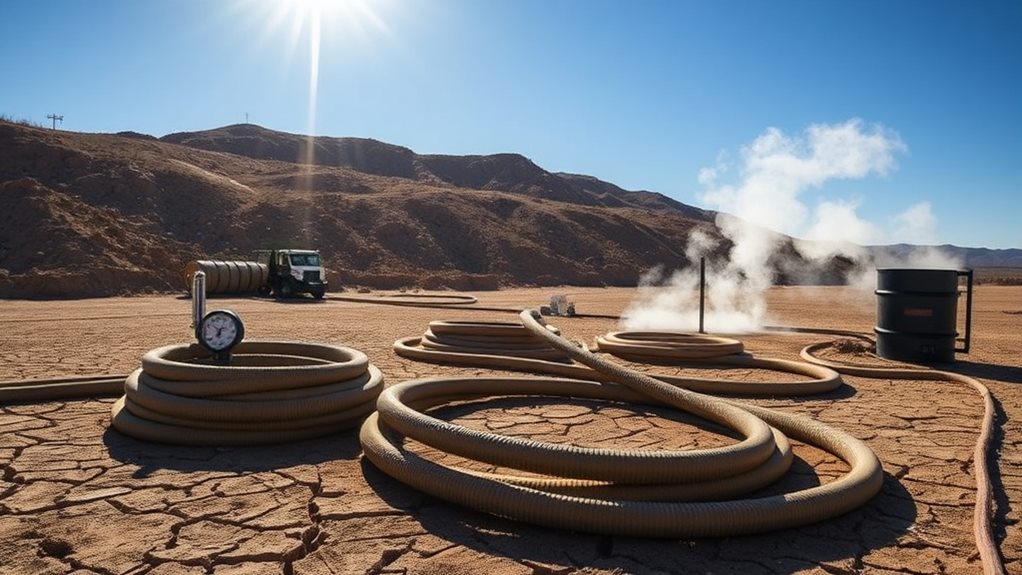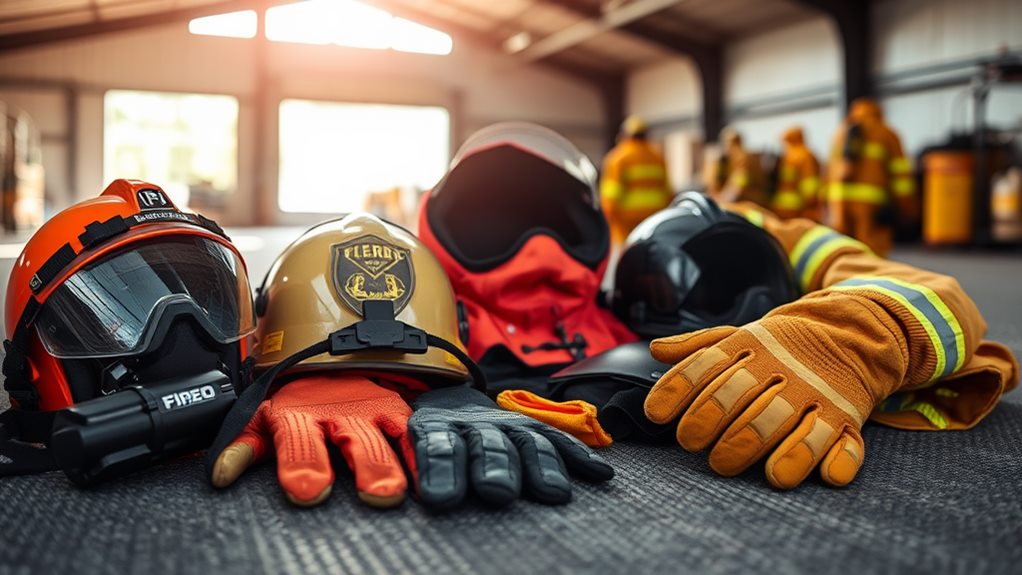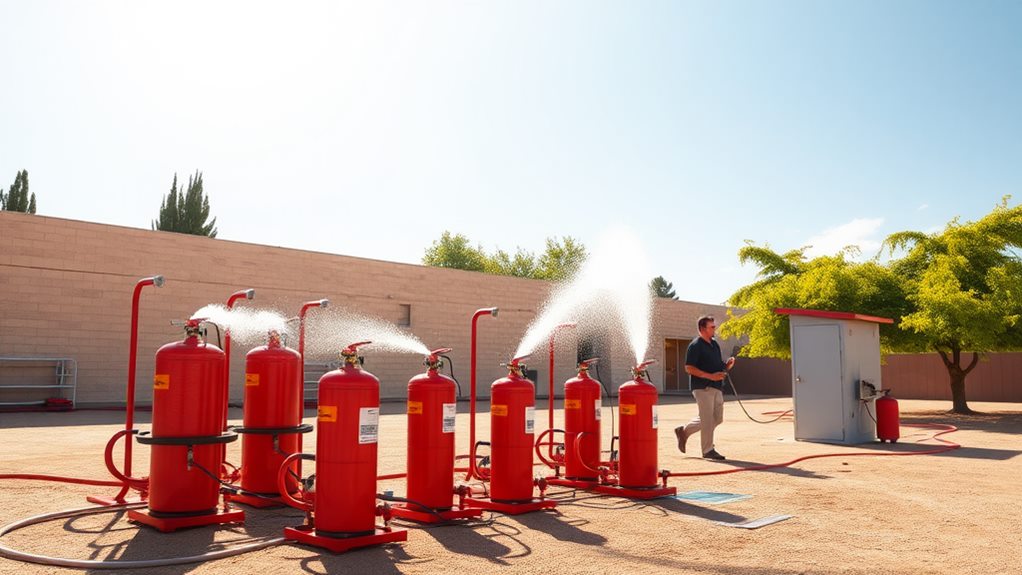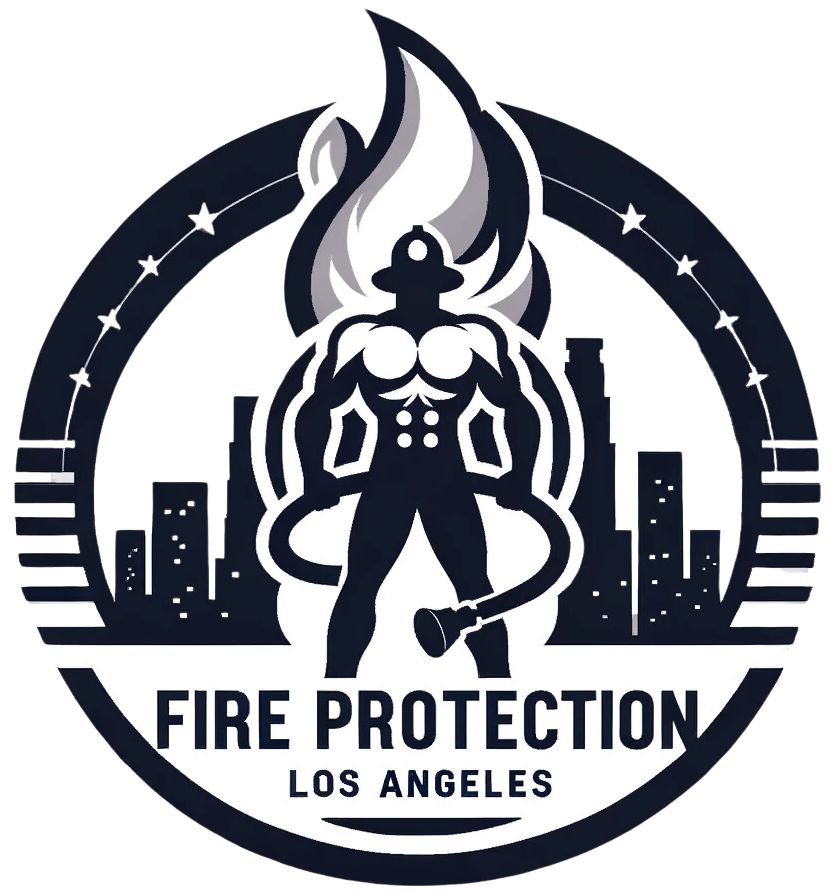Managing heat stress in fire suppression training is essential for our safety and effectiveness. We need to stay hydrated by drinking about one liter of water per hour and monitoring our urine color for signs of dehydration. Choosing appropriate Personal Protective Equipment (PPE) that offers breathability can help, as can scheduling regular breaks every 20-30 minutes. It's vital to communicate as a team, sharing observations about each other's well-being. Using active cooling strategies, like misting fans or cooling vests, can also make a big difference. If we prioritize these practices, we can stay safe and perform at our best.
Understanding Heat Stress Risks

Firefighters frequently encounter significant heat stress risks during training, primarily due to intense physical exertion and extreme temperatures. This combination can lead to a rise in core temperature, increasing the likelihood of heat-related illnesses like heat exhaustion and heatstroke.
Additionally, the importance of effective fire safety training can't be overstated, as it prepares firefighters for emergencies while also promoting fire safety education. When we wear heavy Personal Protective Equipment (PPE), we may find it even harder to regulate our body temperature. This gear, while necessary for thermal protection performance (TPP), can trap heat and limit sweat evaporation, exacerbating our risks.
The cardiovascular strain we experience during training can be significant. As we push ourselves physically, we might feel fatigued more quickly, which can impair our performance and increase the chance of accidents.
To combat these heat stress risks, we must adopt effective cooling strategies. This includes scheduling breaks and being mindful of our gear selection before heading into intense environments. By choosing lighter, breathable PPE, we can help manage our body's response to heat better.
Understanding these factors is vital for our safety and effectiveness in the field, ensuring we remain prepared and capable when it matters most.
Importance of Hydration Practices
Hydration is essential for us as firefighters, especially during intense training sessions.
We need to recognize the signs of dehydration and follow proper fluid intake strategies, such as drinking about 1 liter of water per hour.
Hydration Guidelines for Firefighters
Maintaining proper fluid levels is vital for us as firefighters, especially during intense training sessions. Hydration plays an essential role in our performance, helping to reduce the risk of heat stress and dehydration. According to NFPA guidelines, we should proactively consume fluids, aiming to drink about 1 liter per hour while working—particularly in high-temperature environments where sweat loss is significant.
Moreover, extensive fire safety training emphasizes the importance of physical readiness, which is closely tied to adequate hydration effective training.
It's important to drink before we even feel thirsty, as thirst can be a late sign of dehydration. Avoiding caffeinated beverages is also key, since they can constrict our blood vessels and elevate heart rates, complicating our hydration efforts.
Regularly monitoring our urine color is a practical way to check our hydration status. Clear urine typically indicates that we're adequately hydrated, which is necessary for peak performance. If our urine appears darker, it's a sign that we may need to increase our fluid intake.
Signs of Dehydration
Recognizing the signs of dehydration is essential for our performance and safety during training. As firefighters, we need to be proactive about hydration, even before we feel thirsty.
To enhance our preparedness, we can also implement a Family Fire Evacuation Plan to guarantee everyone is ready in case of an emergency. Here are some key signs we should watch for:
- Increased Thirst: Thirst is often the first indicator of dehydration, so we should hydrate before it kicks in.
- Dark Yellow Urine: Clear urine signals good hydration, while dark yellow urine indicates we need to drink more fluids.
- Fatigue and Dizziness: These can be serious signs of dehydration and can affect our performance.
- Headaches: A common symptom, headaches can signal that our fluid intake isn't sufficient.
Following NFPA 1584 guidelines, we must consume regular fluids during training to mitigate heat stress risks.
Studies show that we can lose about 1 liter of sweat per hour of intense activity, so it's important to drink enough water or electrolyte solutions.
Let's avoid caffeinated beverages, as they can worsen dehydration.
Optimal Fluid Intake Strategies
Effective fluid intake strategies are essential for our performance and safety during fire suppression training. Hydration plays a significant role in preventing heat stress and maintaining our effectiveness, particularly when engaging in hands-on training with tools and equipment.
The NFPA guidelines recommend that we consume fluids regularly before, during, and after firefighting activities. It's important to drink more than just when we feel thirsty, as we can lose around 1 liter of sweat every hour while working hard.
To optimize our hydration, we should avoid caffeinated beverages, which can restrict blood vessels and raise our heart rates. Instead, we should focus on water or electrolyte-rich drinks that replenish our body's moisture barrier and support electrolyte balance.
Clear urine is a sign of adequate hydration, while dark urine indicates dehydration, prompting us to drink more fluids immediately.
Maintaining our electrolyte balance with carbohydrate or electrolyte beverages is essential, too, as imbalances can severely affect our performance and safety.
Selecting the Right PPE

When it comes to selecting the right Personal Protective Equipment (PPE) for fire suppression training, we need to prioritize both safety and comfort.
The right PPE can drastically reduce heat stress while ensuring we're protected during challenging scenarios. To help us choose wisely, here are some key factors to evaluate:
- Thermal Protective Performance (TPP): Look for PPE that meets the NFPA 1971 standard, ensuring it provides adequate thermal protection.
- Total Heat Loss (THL): Select gear that allows for effective cooling, helping maintain a safe body temperature during intense activities.
- Dual Certified Options: Assess dual certified, single-layer fatigues since they can reduce overexertion compared to traditional multi-layered gear.
- Proper Fit: Make sure our PPE fits well because ill-fitting gear can trap heat and moisture, increasing our risk of heat stress.
Effective Cooling Strategies
When it comes to managing heat stress during fire suppression training, we need to focus on effective cooling strategies.
Taking regular breaks, staying hydrated according to NFPA guidelines, and using innovative cooling technologies can make a big difference.
Breaks and Rest Periods
Managing heat stress during fire suppression training hinges on our approach to breaks and rest periods. These scheduled breaks are vital for our recovery and help prevent overheating. After every 20-30 minutes of intense activity, we should take at least 10-20 minutes to cool down.
Here are some effective strategies to enhance our breaks:
- Find Shade or Rehab Stations: Access to shaded areas can greatly lower our core temperature and improve recovery rates.
- Monitor for Signs of Overheating: During breaks, we should watch for dizziness or blurred vision, which can indicate overheating and requires immediate attention.
- Utilize Active Cooling Methods: Techniques like misting fans or ice vests can drop our core temperature by up to 1.22°F, making breaks more effective.
- Prioritize Hydration: Although we'll discuss hydration in detail later, it's important to drink water or electrolyte-replenishing beverages during these rest periods to prevent heat-related illnesses.
Hydration Practices and Guidelines
After we've taken our breaks and allowed our bodies to cool down, it's time to focus on hydration practices. For us firefighters, staying hydrated during training is essential to prevent heat stress and dehydration.
The NFPA 1584 recommends that we drink at least one liter of water per hour while engaged in physically demanding tasks. This proactive approach helps maintain peak hydration levels and supports our overall performance.
It's important to drink fluids regularly, even before we feel thirsty, as thirst can be an early sign of dehydration. We should avoid caffeinated beverages since they can constrict blood vessels and raise heart rates, worsening heat stress conditions.
Instead, we can choose electrolyte-rich drinks to maintain our electrolyte balance, which is critical for our health during intense training.
Incorporating scheduled hydration breaks into our training routines is also a smart move. These breaks greatly enhance our recovery and reduce the risk of heat-related illnesses.
By prioritizing hydration, we can't only protect ourselves but also guarantee we're always at our best when facing the challenges of firefighting.
Let's stay hydrated and safe!
Innovative Cooling Technologies
In the quest to combat heat stress during fire suppression training, innovative cooling technologies play an essential role in our safety and performance. We need to utilize effective cooling methods to guarantee we remain safe and efficient in extreme conditions. Here are some strategies we can adopt:
- Active Cooling Methods: Techniques like immersion in ice water or using misting fans can markedly lower our core body temperatures, offering more relief than passive methods.
- Morning Pride Gear Shield: This gear enhances firefighter safety by allowing breathability while preventing smoke particles from contacting our skin, improving air circulation and reducing heat stress.
- Self-Regulating Vents: The Morning Pride Heat Release Liner features vents that help trapped warm air escape, optimizing our comfort during intense operations.
- Cooling Vests: Incorporating these garments into our training can aid in temperature regulation, providing vital cooling support when we need it most.
Following NFPA 1584 guidelines, we must prioritize these active cooling methods as standard procedures for heat stress mitigation during fire suppression training.
Promoting Team Awareness

Effective team awareness is vital for preventing heat stress during fire suppression training. By promoting team collaboration, we can guarantee everyone stays hydrated and recognizes the symptoms of heat stress early. Regular training sessions focused on heat stress awareness help improve our crew's safety, making certain all members understand the risks associated with heat exposure.
Open communication within our team is essential. We should feel comfortable sharing our physical status and any signs of heat stress, creating a culture of safety and vigilance. Implementing a buddy system during training can greatly enhance our monitoring efforts; by checking on each other, we can detect heat stress symptoms before they escalate.
We also need to integrate the NFPA guidelines into our training. These guidelines emphasize the importance of hydration and recovery protocols, which we should practice consistently.
Regular Health Assessments
Regular health evaluations play an essential role in guaranteeing our fitness for duty as firefighters, especially when it comes to managing heat stress. By monitoring our health, we can identify risk factors like obesity and cardiovascular conditions that could impact our performance. The NFPA standards emphasize the importance of pre-service medical evaluations, helping us establish health baselines and identify those at greater risk for heat-related illnesses.
To give you a clearer picture, let's look at some key aspects of regular health evaluations:
- Annual Physical Exams: These are vital for evaluating our overall fitness levels and ability to recover from heat stress.
- Monitoring Health Indicators: Keeping track of our body mass index (BMI) helps us understand our susceptibility to heat stress.
- Timely Interventions: Routine checkups allow us to notice changes in our health status and address issues before they become serious.
- Personalized Health Assessments: Tailoring evaluations to our individual needs guarantees we get the specific care necessary to maintain our health.
Final Thoughts
In summary, managing heat stress during fire suppression training is essential for everyone's safety and performance. Did you know that around 60% of heat-related illnesses occur in outdoor workers? By staying hydrated, choosing the right personal protective equipment, and implementing effective cooling strategies, we can create a safer training environment. Let's work together to promote awareness and conduct regular health assessments, ensuring we all stay healthy and ready for any challenge.








